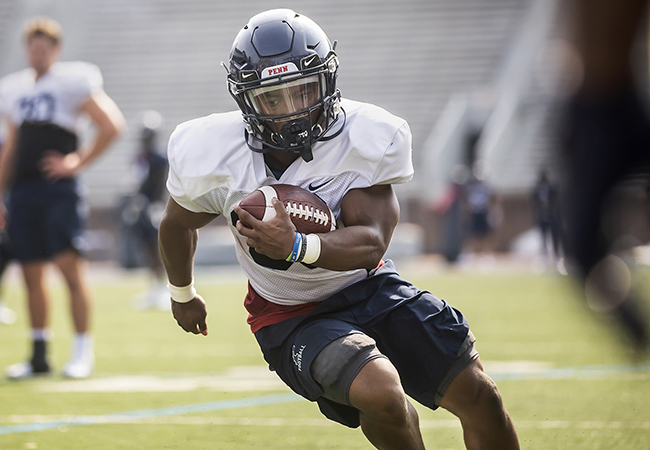What does the NCAA’s new constitution mean for schools and athletes? Penn GSE’s Karen Weaver, an expert on college athletics, provides some insight

The National Collegiate Athletic Association (NCAA) is considering unprecedented changes to its structure and governance. This week, the NCAA is holding a Constitutional Convention in Indianapolis, where its new constitution is slated to be voted on. Following the vote, the NCAA expects divisions to review their own rules and adopt changes in time to be effective in August 2022 for the new academic year.
The changes will undoubtedly be a sea change for college athletics. Penn GSE’s Karen Weaver is an expert on college sports as they intersect with higher education management, media, and policy, as well as a former Division I and Division III head coach and athletics administrator. We asked Weaver what has prompted the NCAA to consider such drastic changes, where the process currently lies, and what administrators should be thinking about.
Q: The NCAA is considering major constitutional changes to how it governs sports programs at its 1100 member schools. How did we get here?
The NCAA structure has been under increasing pressure over the last two decades and has sustained multiple lawsuits that have cost the membership millions, from student-athlete health and welfare (like concussions) all the way to the structure of how the NCAA distributes their revenues from the basketball tournament and how they do or do not punish schools that break the rules.
There is enormous pressure, both internally and externally, that the NCAA must change. One of the strongest pushes is to allow athletes a stronger voice in the NCAA structure.
What drove that was a convergence of multiple factors: the increasing focus by House and Senate committees on “reforming” the NCAA (with the assumption that the membership was incapable of doing it for themselves); state legislatures granting state-by-state permission for athletes to monetize their own name, image, and likeness (NIL); and the decisive Supreme Court ruling that now permits institutions at the FBS level (the top level of college football) to provide unlimited educational benefits to revenue producing athletes.
The NCAA threatened to pull all post-season championships from California, taking away a prestigious opportunity to showcase a campus. The state legislature did not back down. It’s the first time anyone really said no to the NCAA, and then the dominoes started falling with other states creating their own legislation.
Parallel, the US Supreme Court decided NCAA v. Alston, which accused the NCAA rules of creating an artificial “price-fixing” or “capping” of the educationally related benefits that Division I athletes earn through the “scholarship.” Under the Sherman Antitrust Act, no company can control and cap the “benefits” unilaterally. Now, conferences can cap what schools can provide in terms of the “educational benefits” (paying for good grades, graduate school, paid internships, even medical school). Some schools will place this money in a trust fund to be distributed upon graduation.
The Court ruled 9-0 against them, and said this policy was completely in violation of antitrust laws.
The tricky thing is higher education loves to borrow ideas from itself. If other schools or conferences decide to institute this policy, you have the same problem again.
Q: So, in a sense, if the conferences try to create a “level playing field” by all offering the same benefits, the same problems may still exist — they just won’t be the NCAA’s problem.
Exactly. If you can legislate it nationally, there’s an antitrust issue.
Q: There’s a lot that’s unresolved, but what, if anything, is exciting to you?
I’m always really thrilled when athletes can have a seat at the table. This is something that has been talked about for so long, and there has been a lot of lip service by college administrators — which is unfortunate, because it’s the athlete’s experience — so I think this is a positive step in the right direction.
Also, throwing a lifeline to Division 2/ Division 3 schools by ensuring they are able to participate in the postseason. They deserve more money and deserve to have equitable experiences.
Q: These changes are supposed to go into effect in August. Is that realistic?
The first iteration of the draft constitution was a miss; in a Zoom conversation with the membership in November there were only two points of agreement. They’re starting at possibly the lowest common denominator: more athletes should be involved, and athletes should be on committees.
If the three divisions are going to stand on their own and need to each develop their own rules and structure, Division 1 controls the resources to do those kinds of things. There was also an acknowledgment in the meeting that Division 2 and Division 3 schools need money, too.
Overall, though, there’s a lot that has yet to be resolved and agreed upon.
Q: So … what happens now?
We’ve already launched into the world of names, images, and likeness. It is the wild, wild west, where almost any school or athlete can do anything to get money because it has been left up to the individual institutions. For example, Texas has an entire website for access to athletes, where you can reach out to them directly.
It’s stunning. My fear is we are going to end up in this place where maybe a student is offered a nice house off campus, or students are being offered tuition for grad school or medical school. This has the potential to be used to “buy” players.
There are so many issues that have yet to be resolved — and a million people trying to take advantage. There’s no wrong in this situation. Everyone is testing their creativity, storytelling, and ability to leverage followers. We want students to learn how to be entrepreneurial. This is a great opportunity for them to learn that, so why should these new policies be positioned as a bad thing?
The question for institutions is: where does it end? I think what presidents and athletic directors appreciated about the NCAA is there were guardrails, and you knew where they were 90 percent of the time. The culture of the system created this whole entity of rule followers because there were so many penalties if you didn’t follow the rules.
Now there are almost no rules, to the point that when you hear about the NCAA punishing a school you feel surprised.
Q: What should administrators be thinking about right now? Are there specific actions schools should be taking, or are we in a bit of a “wait and see” period?
It’s a little of both: wait and see and monitor what everyone else is doing and what’s happening in the world. We’re watching all this happening with lightning speed, and we don’t know where it stops. That’s what concerns us.
I do think about the impact on institutions, particularly ones that are struggling year in and year out to balance budgets and still offer a competitive experience. How do you attract and retain athletes? That’s what senior campus leaders are really struggling with the most, particularly for smaller schools. Division 2 and Division 3 schools are definitely impacted, but even smaller Division 1 schools are chasing after the elusive big money dollars, and some of them are changing conferences to do it. People are pursuing what has the most chance of the highest money, but not everyone can do that. The difference has been wide for a long time, but now it’s going to be astronomical.

